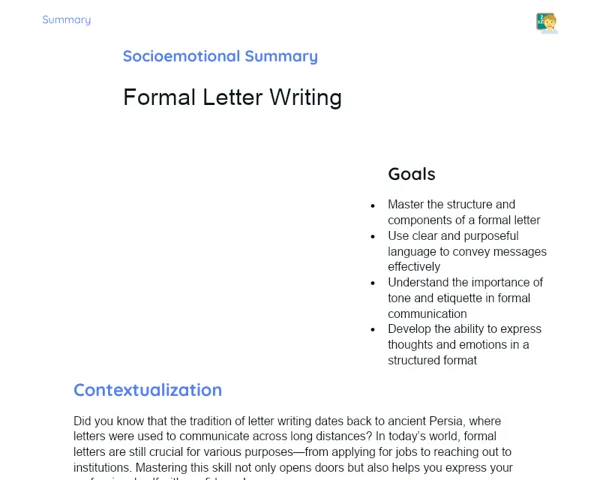Summary Tradisional | Possessive Pronouns
Contextualization
Possessive pronouns are essential words that show ownership or belonging. In English, we commonly use terms like 'my', 'your', 'his', 'her', 'its', 'our', and 'their' to express who owns something. These pronouns play a vital role in our conversations, helping to clarify ownership of objects or ideas and preventing any mix-ups.
For instance, in the sentence 'This is my book', the word 'my' tells us that the book is owned by the speaker. Similarly, in 'That is her pen', the pronoun 'her' indicates that the pen belongs to someone else. Grasping and using possessive pronouns correctly is key for effective communication in English, whether it's in casual chats or more formal discussions.
To Remember!
Definition of Possessive Pronouns
Possessive pronouns are words that indicate ownership. In English, these include: 'my', 'your', 'his', 'her', 'its', 'our', and 'their'. They function to show who owns an object or idea, replacing the possessive noun. For example, instead of saying 'the book of John', we can say 'his book'.
It's important to note that possessive pronouns differ from possessive adjectives, as the former do not need to be followed by a noun. For instance, in 'This is my book', 'my' acts as a possessive adjective, whereas in 'This book is mine', 'mine' serves as a possessive pronoun.
A solid understanding of possessive pronouns is crucial for effective communication in English, as they help pinpoint who owns something without needing to repeat the noun. This makes conversations flow more naturally and avoids redundancy.
-
Possessive pronouns indicate ownership.
-
They help avoid repeating nouns.
-
They are different from possessive adjectives.
Correct Use of Possessive Pronouns
Using possessive pronouns correctly means replacing them in place of the noun indicating ownership. For instance, 'This is my book' can be expressed as 'This book is mine'. Here, 'mine' takes the place of 'my book', showing clear possession without repeating the noun.
Each possessive pronoun corresponds to a particular subject: 'my' for 'I', 'your' for 'you', 'his' for 'he', 'her' for 'she', 'its' for 'it', 'our' for 'we', and 'their' for 'they'. Ensuring the correct pronoun is used is vital to avoid any confusion regarding ownership.
Additionally, possessive pronouns can stand alone without needing a noun afterwards. For example, saying 'This pen is yours' is correct, but 'This pen is your' is incorrect. This clarity contributes to effective and concise communication.
-
They replace possessive nouns.
-
They associate with specific subjects.
-
Used without needing a noun to follow.
Difference Between Possessive Pronouns and Possessive Adjectives
Possessive pronouns and possessive adjectives serve different purposes in sentences. Possessive adjectives always accompany a noun, modifying it to reflect possession. For instance, in 'This is my book', 'my' is a possessive adjective that modifies 'book'.
Conversely, possessive pronouns replace the noun that has already been mentioned or is implied from the context. Take 'This book is mine'; here, 'mine' substitutes 'my book', helping avoid repetition and making sentences more concise.
Recognizing the difference between the two forms is important for correct usage and clarity in communication. While possessive adjectives directly modify nouns, possessive pronouns take the place of those nouns.
-
Possessive adjectives accompany nouns.
-
Possessive pronouns take the place of nouns.
-
Using them correctly maintains clarity.
Practical Examples and Exercises
To deepen our understanding of possessive pronouns, it's crucial to engage with practical examples and exercises. For example, change the sentence 'This is the book of John' to read 'This is his book'. Another transformation would be 'The pen of Maria is blue' becoming 'Her pen is blue'.
Exercises enable us to pinpoint and use possessive pronouns accurately across different contexts. For instance: 'This book belongs to John. It is ____.' The right answer would be 'his'. Another practice could be: 'The house of Maria is big', which should be rephrased as 'Her house is big'.
Such exercises not only strengthen theoretical knowledge but also provide a platform for students to apply what they have learned in real-world contexts, enhancing the learning experience.
-
Practice through sentence transformation.
-
Exercises help identify and use possessive pronouns.
-
Real-world application boosts learning.
Key Terms
-
Possessive Pronouns: Words that indicate ownership, such as 'my', 'your', 'his', 'her', 'its', 'our', 'their'.
-
Possessive Adjectives: Words that modify nouns to indicate ownership, like 'my', 'your', 'his', 'her', 'its', 'our', 'their'.
-
Possession: Indicating that something belongs to someone.
-
Nouns: Words that name people, places, things, or ideas.
Important Conclusions
Possessive pronouns in English, like 'my', 'your', 'his', 'her', 'its', 'our', and 'their', are crucial for indicating ownership and avoiding unnecessary repetition of nouns. They clarify to whom a specific object or idea belongs, promoting understanding and effective communication. The distinctions between possessive pronouns and possessive adjectives have also been highlighted, noting that pronouns replace nouns while adjectives modify them directly.
Using possessive pronouns correctly is essential to prevent confusion and to ensure clear communication. Practical examples and exercises have been integrated to reinforce understanding, allowing students to apply their knowledge in real contexts, which strengthens learning and aids retention.
Having a grasp of how to properly use possessive pronouns is a foundational skill in English communication, whether in casual conversations or more formal exchanges. This not only enhances clarity but also helps avoid misunderstandings. Continuous practice and application of this knowledge across various scenarios will empower students to master the use of possessive pronouns confidently.
Study Tips
-
Regularly review possessive pronouns and adjectives, practicing their use in various sentences.
-
Engage in sentence transformation exercises, swapping possessive nouns for possessive pronouns to strengthen understanding.
-
Read English texts while paying attention to possessive pronouns, observing how they replace nouns to show ownership.



